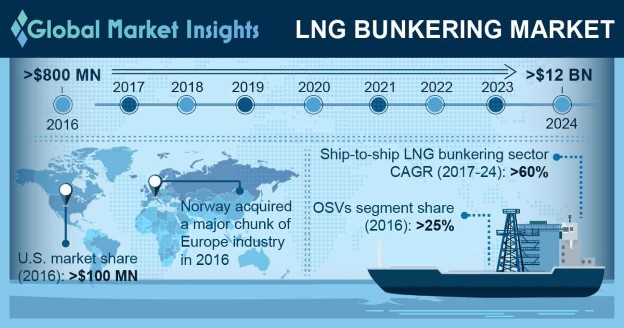Home > Energy & Power > Oil and Gas > Bunkering > LNG Bunkering Market
LNG Bunkering Market Size
- Report ID: GMI702
- Published Date: Jun 2017
- Report Format: PDF
LNG Bunkering Market Size
LNG Bunkering Market size for 2016 was valued over USD 800 Million and the capacity is set to exceed 18,500 kilotons by 2024.

Shifting trends towards clean energy coupled with stringent government regulations to minimize airborne emissions including sulfur and nitrous oxide will drive the global LNG bunkering market size. Ability to reduce carbon emission by 20% to 25% will make its adoption preferable over other available counterparts. In 2015, IMO and MARPOL introduced strict norms to reduce the sulfur and nitrous content with an aim to reduce the marine pollution. Technological advancement in vessel designs to reduce maintenance, enhance fuel efficiency and improve performance, reliability and safety are some of the key parameters which will stimulate the product demand. Strong orderbook for LNG-propelled vessels subject to the implementation of IMO Tier III norms will further complement the industry growth.
Shifting trend towards sustainable fuel coupled with increasing shale production will foster the LNG bunkering market. In the U.S. shale gas production reached from 13,447 bcf in 2015 to 15,213 bcf in 2016. Growing demand for reliable, eco-friendly and low-cost marine fuel will further complement the business landscape. Vancouver bunker prices for LNGe-380 were USD 255/ mt when compared to IFO 380 floating of USD 284 in May 2017.
| Report Attribute | Details |
|---|---|
| Base Year: | 2016 |
| LNG Bunkering Market Size in 2016: | 800 Million (USD) |
| Forecast Period: | 2017 to 2024 |
| 2024 Value Projection: | 12 Billion (USD) |
| Historical Data for: | 2013 to 2016 |
| No. of Pages: | 200 |
| Tables, Charts & Figures: | 250 |
| Segments covered: | Product, End-Use and Region |
| Growth Drivers: |
|
| Pitfalls & Challenges: |
|
